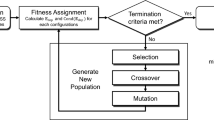Abstract
The neutron-beam pulse structure (0.3-ms-long power pulses repeated with a period of 200 ms) at the IBR-2 research reactor (operated by Frank Laboratory of Neutron Physics, Joint Institute for Nuclear Research (JINR), Dubna) is obtained by modulating reactor core reactivity. However, the neutron flux between power pulses does not fall to zero; due to the continuous emission of delayed neutrons from the fissile material of the reactor core, it remains at a quasi-constant level, which is approximately 10–4 of the maximum neutron flux in the reactor power pulse. Based on this observation it is generally believed that, due to such a background, the minimal measurable scattered neutron signal is fundamentally limited at a level of 10–4 of the incident beam intensity, a value which is actually observed in reflectometry and small-angle experiments at the IBR-2 reactor. As a result, it is concluded that that the experimental capabilities of pulsed neutron sources with reactivity modulation are fundamentally flawed, which may have a serious impact on the design of the new IBR-3 high-flux neutron source at JINR. Virtual experiments have been used in this study to show that, for a reflectometer equipped with a disk background chopper, which is standard for the IBR-2 reactor, the minimal measurable reflectivity coefficient may be as low as 10–8. This result completely invalidates the assumptions about the critical impact of the delayed-neutron background on the experiments based on pulsed neutron sources with reactivity modulation. The single actual source of the background at a level of 10–4 observed at the IBR-2 reactor can be the external background of neutrons from the intrinsic beam that miss the target and other neutron reactor beams due to insufficient shielding of the detector.









Similar content being viewed by others
REFERENCES
G. S. Bauer, “Physics and technology of spallation neutron sources,” Nucl. Instrum. Methods Phys. Res., Sect. A 463, 505 (2001).
V. N. Shvetsov, “Neutron sources at the Frank Laboratory of Neutron Physics of the Joint Institute for Nuclear Research,” Quantum Beam Sci. 1, 6 (2017).
V. D. Anan’ev et al., “Start-up and study of the main characteristics of the IBR-2 reactor with a new heterogeneous reactivity modulator,” JINR Preprint No. P13-2004-156 (JINR, Dubna, 2012).
K. Lieutenant, G. Zsigmond, S. Manoshin, M. Fromme, H. N. Bordallo, D. Champion, J. Peters, and F. Mezei, “Neutron instrument simulation and optimization using the software package VITESS,” in Advances in Computational Methods for X-Ray and Neutron Optics, Ed. by M. Sanchez del Rio, Proc. SPIE 5536, 134–145 (2004). https://doi.org/10.1117/12.562814
S. Mattauch, A. Ioffe, D. Lott, L. Bottyán, J. Daillant, M. Markó, A. Menelle, S. Sajti, and T. Veres, “HERITAGE: The concept of a giant flux neutron reflectometer for the exploration of 3-D structure of free-liquid and solid interfaces in thin films,” Nucl. Instrum. Methods Phys. Res., Sect. A 841, 34–46 (2017). https://hal.archives-ouvertes.fr/hal-01553931. https://doi.org/10.1016/j.nima.2016.09.043
Funding
These results were obtained with financial support from the Ministry of Science and Higher Education of the Russian Federation, agreement no. 075-10-2021-115 dated October 13, 2021 (internal number 15.SIN.21.0021).
Author information
Authors and Affiliations
Corresponding author
Additional information
Translated by M. Shmatikov
Rights and permissions
About this article
Cite this article
Bodnarchuk, V.I., Sadilov, V.V. Impact of the Background of Delayed Neutrons on the Capabilities of Experimental Facilities Based on Pulsed Reactivity-Modulated Neutron Sources. Phys. Part. Nuclei Lett. 19, 145–151 (2022). https://doi.org/10.1134/S1547477122020029
Received:
Revised:
Accepted:
Published:
Issue Date:
DOI: https://doi.org/10.1134/S1547477122020029




